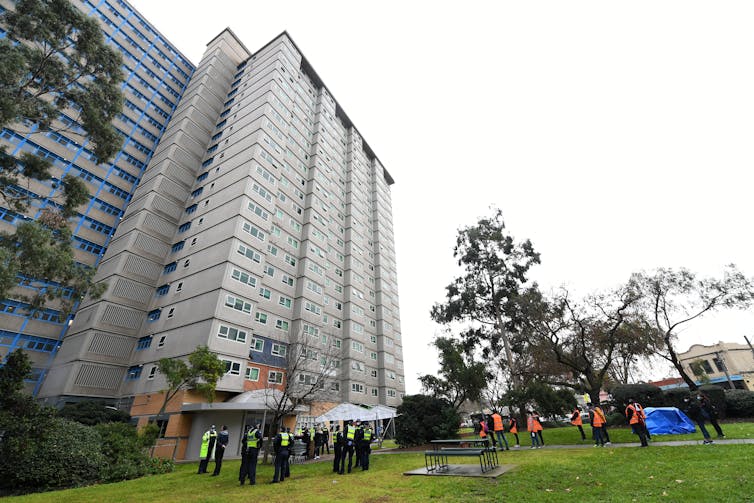Metropolitan Melbourne and Mitchell Shire return to lockdown: this is just how vigilant we have to be until a COVID-19 vaccine is found
- Written by Philip Russo, Associate Professor, Director Cabrini Monash University Department of Nursing Research, Monash University
Metropolitan Melbourne and the shire of Mitchell will returned to Stage 3 stay-at-home restrictions as of midnight Wednesday, Premier Daniel Andrews has announced, after 191 new cases were recorded in the state overnight - its highest ever daily case total.
The lockdown means for the next six weeks, people in metropolitan Melbourne and the shire of Mitchell will only be able to leave home for one of four reasons:
- food shopping
- caregiving
- exercise, and
- to study or work (if you can’t do it at home).
Andrews said people cannot leave metropolitan Melbourne to get daily exercise (so, no bushwalks or fishing outside the city) and people must stay at their principal place of residence. That means no escaping to a holiday home.
School holidays will be extended for many students, although some — including students in year 11 and 12 or specialist schools — will return to school when the holidays end, he said. Children of essential workers will be able to attend supervised holiday programs.
At least nine Melbourne housing blocks are now in day four of a hard lockdown, under which they are not allowed to leave for any reason.
Today’s announcement comes as NSW Police and Australian Defence Force personnel gather to enforce the NSW-Victorian border closure announced earlier this week. Police have warned of “dire consequences” — including jail time or hefty fines — for those who those who try to cross without an exemption permit.
A return to citywide lockdown is unsettling, but the good news is we know restrictions work when we adhere to the recommendations.
We can bring COVID-19 case numbers down, as long as we follow the golden rules: meticulous hand washing, maintaining physical distancing, staying home when unwell and getting tested if you have any COVID-19 symptoms.
From a public health point of view, a return to lockdown for the whole of metropolitan Melbourne is the logical thing to do right now. It’s time to accept that moving in and out of various levels of restriction may just be a part of life as we know it in 2020, and likely 2021.
Read more: Here's how the Victoria-NSW border closure will work – and how residents might be affected
Life as normal doesn’t exist for 2020
For many Victorians, this will feel frustratingly like a reset; back to square one. For the rest of Australia, it’s disquieting news — a reminder this situation could occur at any time in any other state or territory. None of us can be complacent.
It’s hard, but this is just how vigilant we have to be until a vaccine is found. We’re all keen to go back to “life as normal” but the reality is, life as normal doesn’t exist for 2020.
Restrictions will have to be scaled up and down as needed in response to local outbreaks. It’s not just a matter of doing lockdown once and then going back to “normal” after the numbers come back down.
We have to accept the fact that this is an abnormal year, and the lives we had planned for ourselves as of January 1 aren’t going to pan out like we’d hoped.
We know people are getting weary of this; we are too. To go back to step one is a dent in the armour and authorities will need to think carefully about how to manage frustration. But we all need to prepared to be agile and flexible in how we respond to case numbers.
 At least nine housing towers in Melbourne have been placed in ‘hard lockdown’ for several days.
JAMES ROSS/AAP
At least nine housing towers in Melbourne have been placed in ‘hard lockdown’ for several days.
JAMES ROSS/AAP
Hard lessons learned
Severe lessons have been learned along the way, chiefly the reported breaches in infection control guidelines at the quarantine hotels. It shows that even if 99% of the system is working, a breakdown in one aspect of infection control is enough to cause a resurgence.
In a way, the high number of cases being detected is a sign that the detection and contact tracing system is working. That’s reassuring.
But flareups have been a feature of this pandemic all along. What’s important is how they’re managed, and a return to restrictions is a necessary evil.
And, as always, the key messages are about getting tested if unwell, washing hands properly, following the stay at home recommendations, not mixing with others and understanding that physical distancing is still our best defence.
Masks on their own are not enough to keep you safe, but people who live in lockdown “hot spot” suburbs in Victoria should probably consider wearing them in places where physical distancing can’t be maintained in those areas, such as supermarkets.
But for the rest of Australia outside those hotspots, public wearing of masks is not yet recommended.
The bottom line is we all have a role to play when it comes to stemming the spread of COVID-19 and reducing the chance we will need another lockdown in future.
Clearly, that hasn’t always happened in Victoria and we are now seeing the consequences.
Read more: Coronavirus spike: why getting people to follow restrictions is harder the second time around

